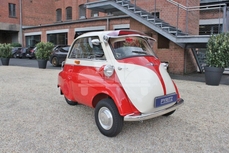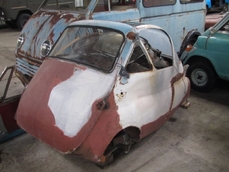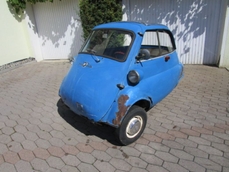BMW Isetta Coupe 1958
General description :
The BMW of today, with its tech-laden super-sedans, hybrid sports cars, and ultra-luxury SUVs would probably not exist if it weren’t for an Italian appliance company named Isothermos. The loose connection began in 1942 when by a young engineer and heir to an industrial fortune, Renzo Rivolta purchased Isothermos. With a passion for motoring, Rivolta began to expand the company’s range, adding motorbikes to the portfolio and renaming the works Iso Autoveicoli S.p.A. After World War II, Europeans were desperate to get back on wheels, but with raw materials and fuel at a premium, few could afford a conventional car. Motorbikes and scooters became hugely popular, but they were impractical in bad weather or for families. As a way to bridge the gap between bike and car, some manufacturers turned to motorbike-powered microcars that offered cheap, efficient, and practical transport for the masses.
Wanting to cash in on this new market, Renzo Rivolta began development of a 2-passenger microcar with a single front clamshell door, and a small capacity motorbike engine mounted amidships. Introduced in 1953, the Iso Isetta Turismo was the quintessential cheeky bubble car. It was adorable, it could transport two people and some groceries, and it was highly efficient, if not particularly quick thanks to having just 236cc and 9 ½ horsepower. It turned out to be reasonably successful in the home market, with 20,000 built at the Iso works in Milan.
Renzo Rivolta recognized a viable market for the Isetta; however, he lacked the manufacturing capacity to meet Europe-wide demand. Rivolta’s stroke of genius came in 1954 when he sold the rights to the design to several different companies in Europe and South America. Among those firms was BMW, who was struggling through the post-war recovery. Most of their factories were devastated by bombing, and their Eisenach works fell within Russian-controlled East Germany. BMW’s post-war product line consisted mainly of expensive six and eight-cylinder luxury cars that, while capable, had limited appeal in the post-war economy. Without the time and resources to develop a small car, the Isetta was the perfect opportunity to support the bottom line. Of course, they couldn’t help but to fettle with the design, modifying it to accept a 250 c.c. four-stroke engine shared with the R25/3 motorcycle and making minor styling changes. In 1956, BMW bumped the capacity to 298cc which gave the new Isetta 300 nearly one-and-a-half times the power output over the 250. With a storming 13 horsepower on tap, not even hills could stop BMW’s mighty-mouse! The Isetta continues to delight today’s collectors, and even the most serious collections make room for the adorable – yet historically significant – German bubble car.
This beautiful 1958 example is of the best sliding-window Isetta 300s we’ve had the pleasure to offer. It is meticulously restored and detailed to a very high standard, finished in the factory shade of Weisgold, code 106. The attention to detail is exemplary, particularly the quality of the bodywork and gorgeous paint. Excellent brightwork accents the lovely color scheme with the body equipped with optional bumper “over riders” as well as the integrated bumpers finished in exquisite chrome. The finishing touch is a set of wide whitewall tires on original steel wheels dressed with correct original BMW hubcaps. This car’s outstanding presentation makes it easy to see why BMW sold more than 160,000 examples of “the egg” and why it remains so beloved by enthusiasts around the world.
The cozy 2-place cockpit is restored to the same exacting standard as the exterior. Simple heavy-grain interior panels provide a modicum of sound insulation while a rubber mat lines the floor. Tan perforated vinyl covers the bench seat, with matching boots on the shifter and steering column. The bench is reasonably comfortable for two passengers, so long as both occupants are on speaking terms. The Isetta’s party piece is the single, front-mounted clamshell door. The steering column and dash cleverly swing out of the way on a series of universal joints allowing for easy ingress. Once situated behind the wheel, the Isetta is surprisingly airy thanks to the panoramic windshield and generous greenhouse. The fabric sunroof (fitted to every Isetta built) also helps, and it doubles as a secondary exit should the front door become blocked. Much like the body, the quality of the materials and finishing on the interior is first-rate. Original style labels and stickers are faithfully reproduced; particularly handy is the graphic showing the reverse layout for the four-speed shifter that sprouts from the body at the driver’s left hand. Factory-original switches and controls are restored to like-new condition.
It takes a short time to get used to driving an Isetta, but once comfortable; the experience is pure delight. The single-cylinder, 298cc 4-stroke engine is fizzy and full of character, providing enough power to buzz around town, while the ultra-short wheelbase and narrow rear track make it extremely maneuverable. This example runs very well, and the engine is appropriately detailed, looking exceptionally clean and factory correct beneath the side-mount engine cover.
The Isetta is a significant vehicle in BMW’s illustrious history. It allowed the company to survive during a difficult period, and it spawned the two-cylinder, rear-engine 700 series which gets the credit for rescuing BMW from a takeover attempt by Mercedes-Benz. This tiny car carried the weight of the company on its shoulders. Overflowing with charm and character, this Isetta 300 is a fabulous example and an essential addition to virtually any diverse collection.
https://hymanltd.com/vehicles/6485
1958 BMW Isetta Coupe is listed sold on ClassicDigest in St. Louis by Mark Hyman for $37500.
Car Facts
Car type : Car Make : BMW Model : Isetta Model Version : Coupe Engine size : 0.0 Model Year : 1958 Sub type : Coupé Location : Missouri
Sold
Seller Information
Sold
People who viewed this BMW Isetta also viewed similar BMW listed at ClassicDigest
Other cars listed for sale by this dealer
About BMW
ChatGPT
Bayerische Motoren Werke, commonly known as BMW, has a rich history dating back to its founding in 1916. Initially established as an aircraft-engine manufacturer during World War I, BMW faced restrictions on aircraft production after the war. In response, the company shifted its focus to motorcycle production in 1923, marking the beginning of its involvement in the automotive industry. Subsequently, BMW entered the world of automobiles in 1928 by producing the DIXI, essentially a licensed version of the Austin 7 from the Austin Motor Company.
In the 1930s, BMW began to establish itself as a manufacturer of elegant and high-performance vehicles. One notable model from this era is the BMW 327, introduced in 1937. The 327 was available as both a coupe and a cabriolet, showcasing the brand's commitment to luxury and style. Additionally, BMW achieved success in sports car racing during this period, particularly with the BMW 328. The 328, which debuted in 1936, became renowned for its performance and aerodynamics. BMW campaigned the 328 in various racing events, including the prestigious Mille Miglia, where the company introduced several aerodynamic specials.
The post-war era proved challenging for BMW, and the company faced financial difficulties that nearly led to bankruptcy. However, BMW managed to recover and rebuild, eventually becoming one of the leading premium automotive brands globally.
As the 1960s unfolded, BMW further solidified its reputation for producing sports-oriented and luxurious vehicles. In 1968, the BMW 2002 was introduced, marking the birth of the "New Class" of compact, sporty sedans. The 2002 gained popularity for its agile handling and performance, laying the foundation for BMW's sporty image.
Moving into the 1970s, BMW expanded its lineup with the introduction of the E9 platform, which included the iconic BMW 3.0 CS coupe. The E9 series showcased BMW's commitment to blending performance and luxury. In 1972, the M1, BMW's first mid-engined sports car, made its debut. The M1 was initially developed as a racing car but later became a road-going model. The M1 laid the groundwork for BMW's high-performance M series.
In the late 1970s, the BMW E24 6 Series was introduced, offering a combination of luxury and performance. The 6 Series included models like the 630CS, 633CSi, and 635CSi, becoming a symbol of sophistication and driving pleasure.
Through these milestones and a commitment to innovation and performance, BMW has evolved into a powerhouse in the automotive industry, maintaining its status as one of the leading premium brands worldwide.











